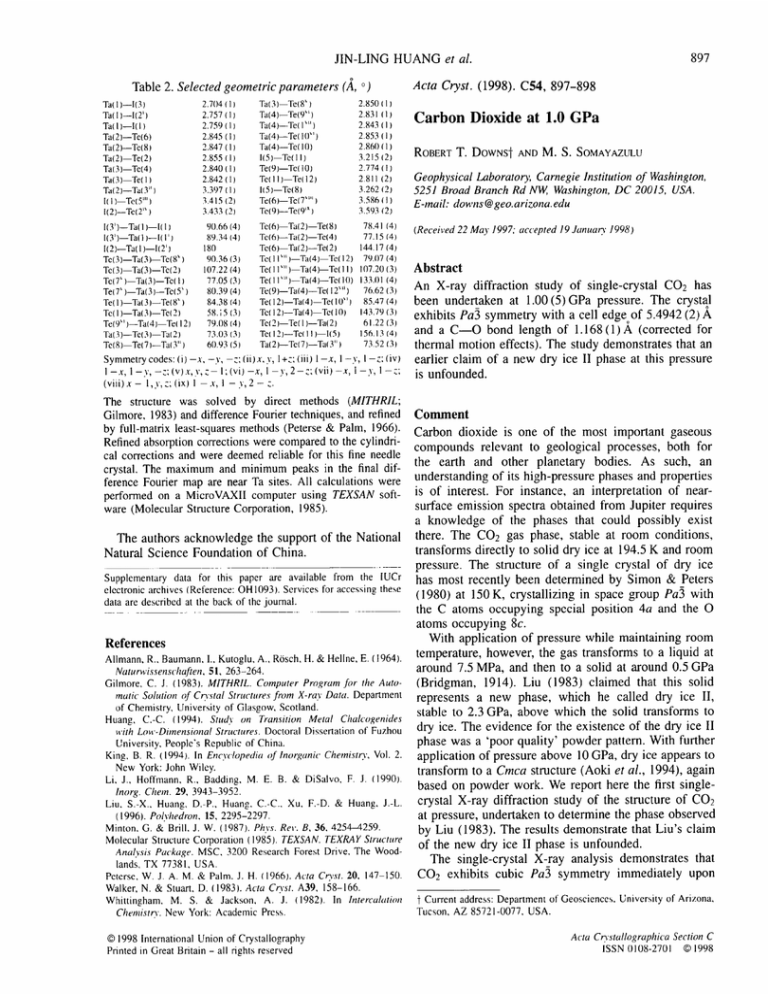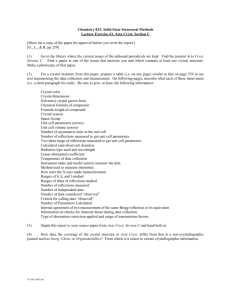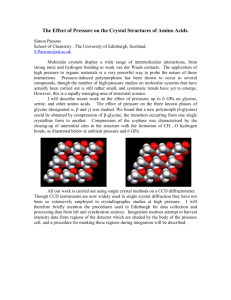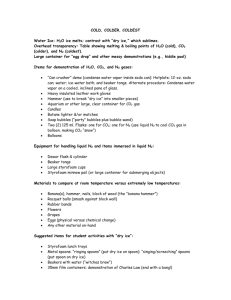
JIN-LING HUANG et al.
Table 2. Selected geometric parameters (A, °)
Ta{ 1)--I{3)
Ta( I )--1{2'}
Ta(I}--l(l)
Ta( 2 )--Te(6)
Ta(2)--Te(8}
Ta(2)--Te(2)
Ta{3)--Te{4)
Ta(3 )--Te{ 1}
Ta(2)--Ta{3" }
I{ I )--Te{ 5"' }
I(2)--Te(2"
)
I(3' }--Ta( I}--1{ 1}
I(3' )--Ta( I }--[( I ' }
l(2)--Ta( 1}--I(T }
Te(3)--Ta(3)--Te(8' )
Te(3}--Ta(3)--Te(2)
Tc(7" )--Ta( 3 )--To( I }
Te(7' )--Ta(3 }--To(5' )
Te( 1)--Ta( 3 )--Te{ 8' )
Te( 1)--Ta(3)--Te( 2 }
Te(9" )--Ta(4}--Te( 12}
Ta(3)--Te(3}--Ta{2}
Te(8)--Te(7 }--Tal3" )
2.704 ( 1
2.757 {1
2.759 ~
2.845
2.847 q
2.855
2.840 q
2.842 q
3.397 ~
3.415 (2)
3.433 (2)
Ta{3}--Te(8' }
Ta(4}--Te(9")
Ta(4)--Te(1'")
Ta(4)--Te{ I0")
Ta(4}--Te(10)
I(5}--Te( 1I}
Te{9)--Te( 10}
Te{ I I }--Te(12)
[{5}--Te(8)
Te(6)--Te(7'"' )
Te(9}--Te(9 'x }
2.850 {11
2.831 (1 ;
2.843 (I)
2.853 (I ;
2.860 ( 1)
3.215 (2}
2.774 ( I }
2.811 (2)
3.262 {2}
3.586 ( I )
3.593 (2)
90.66
89.34
180
90.36
107.22
77.05
80.39
84.38
58.15
79.08
73.03
60.93
Tc(6}--Ta(2)--Te{ 8}
Te(6}--Ta(2)--Te(4}
Te(6)--Ta(2}--Te(2}
Te( 11'" )--Ta(4}--Tc(12)
Te(1 l"')--Ta(4F---Te(I 1)
Te(ll'"}--Ta(4}--Te(10)
Te(9)--Ta{4}--Te(12'")
Te( 12}--Ta{4 }--Te( I 0" )
Tel 12}--Ta(4}--Te(10)
Te{2}--Te{ 1}--Ta(2)
Te{ 12}--Te( 11 )--1(5)
Ta(2)--Te(7J--Ta{3" )
78.41 {4}
77.15 (4}
144.17 (4}
79.07(4)
107.20 (3)
133.01 (4}
76.62 (3}
85.47(4)
143.79(3)
61.22 (3}
156.13 {4}
73.52 (3}
(4}
{4}
(3}
(4)
(3)
(4)
{4}
{3)
{4}
{3}
{5)
Symmetry codes: (i) - x , - y , - z ; (ii) x, y, 1+:; (iii) 1 - x , 1 - y , 1 - z : (iv)
1-x, I-3', -z;(v)x,y,z-
l;(vi} - x , I - y , 2 - : . ; ( v i i ) - x , I - y , 1 - - "
(viii)x- l,y,z;(ix}l -x,l
-y, 2--
The structure was solved by direct methods (MITHRIL;
Gilmore, 1983) and difference Fourier techniques, and refined
by full-matrix least-squares methods (Peterse & Palm, 1966).
Refined absorption corrections were compared to the cylindrical corrections and were deemed reliable for this fine needle
crystal. The maximum and minimum peaks in the final difference Fourier map are near Ta sites. All calculations were
performed on a MicroVAXII computer using TEXSAN software (Molecular Structure Corporation, 1985).
The authors acknowledge the support of the National
Natural Science Foundation of China.
Supplementary data for this paper are available from the IUCr
electronic archives (Reference: OH1093). Services for accessing these
data are described at the back of the journal.
.
.
.
.
.
.
.
.
.
.
References
Allmann, R., Baumann, I., Kutoglu, A., RtJsch, H. & Hellne, E. (1964).
Naturwissenschaften, 51, 263-264.
Gilmore, C. J. (1983). MITHRIL. Computer Program for the Auto-
matic Solution of Crystal Structures from X-ray Data. Department
of Chemistry, University of Glasgow, Scotland.
Huang, C.-C. (1994). Study on Transition Metal Chalcogenides
with Low-Dimensional Structures. Doctoral Dissertation of Fuzhou
University, People's Republic of China.
King, B. R. (1994). In Eno'clopedia of Inorganic Chemisto', Vol. 2.
New York: John Wiley.
Li, J., Hoffmann, R., Badding, M. E. B. & DiSalvo, F. J. (1990).
Inorg. Chem. 29, 3 9 4 3 - 3 9 5 2 .
Liu, S.-X., Huang, D.-P., Huang, C.-C., Xu, F.-D. & Huang, J.-U
(1996). Polyhedron, 15, 2 2 9 5 - 2 2 9 7 .
Minion, G. & Brill, J. W. (1987). Phys. Rev. B, 36, 4254--4259.
Molecular Structure Corporation (1985). TEXSAN. TEXRAY Structure
Analysis Package. MSC, 3200 Research Forest Drive, The Woodlands, TX 77381, USA.
Peterse, W. J. A. M. & Palm. J. H. {1966}. Acta Crvst. 20, 147-150.
Walker, N. & Stuart, D. (1983). Acta Cra'st. A39, 158-166.
Whittingham, M. S. & Jackson, A. J. (1982). In Intercalation
Chemistry. New York: Academic Press.
© 1998 International Union of Crystallography
Printed in Great Britain - all rights reserved
897
Acta Cryst. (1998). C54, 897-898
Carbon Dioxide at 1.0 GPa
ROBERT T . D O W N S t AND M . S . SOMAYAZULU
Geophysical Laboratoo', Carnegie Institution o f Washington,
5251 Broad Branch Rd N ~ , Washington, D C 20015, USA.
E-maih downs@ geo.arizona.edu
(Received 22 May 1997; accepted 19 Janua~" 1998)
Abstract
An X-ray diffraction study of single-crystal CO2 has
been undertaken at 1.00 (5)GPa pressure. The crystal
exhibits Pa3 symmetry with a cell edgeoof 5.4942 (2) A
and a C - - O bond length of 1.168 ( 1 ) A (corrected for
thermal motion effects). The study demonstrates that an
earlier claim of a new dry ice II phase at this pressure
is unfounded.
Comment
Carbon dioxide is one of the most important gaseous
compounds relevant to geological processes, both for
the earth and other planetary bodies. As such, an
understanding of its high-pressure phases and properties
is of interest. For instance, an interpretation of nearsurface emission spectra obtained from Jupiter requires
a knowledge of the phases that could possibly exist
there. The CO2 gas phase, stable at room conditions,
transforms directly to solid dry ice at 194.5 K and room
pressure. The structure of a single crystal of dry ice
has most recently been determined by Simon & Peters
(1980) at 150 K, crystallizing in space group Pa3 with
the C atoms occupying special position 4a and the O
atoms occupying 8c.
With application of pressure while maintaining room
temperature, however, the gas transforms to a liquid at
around 7.5 MPa, and then to a solid at around 0.5 GPa
(Bridgman, 1914). Liu (1983) claimed that this solid
represents a new phase, which he called dry ice II,
stable to 2.3 GPa, above which the solid transforms to
dry ice. The evidence for the existence of the dry ice II
phase was a 'poor quality' powder pattern. With further
application of pressure above 10 GPa, dry ice appears to
transform to a Cmca structure (Aoki et al., 1994), again
based on powder work. We report here the first singlecrystal X-ray diffraction study of the structure of CO2
at pressure, undertaken to determine the phase observed
by Liu (1983). The results demonstrate that Liu's claim
of the new dry ice II phase is unfounded.
The single-crystal X-ray analysis demonstrates that
CO2 exhibits cubic Pa3 symmetry immediately upon
I Current address: Department of Geosciences. University of Arizona,
Tucson, A Z 85721-0077, USA.
Acta Co'stallographica Section C
ISSN0108-2701
©1998
898
CO2
t r a n s f o r m a t i o n to a solid on the application o f pressure.
T h e unit-cell length o f CO2 at 1.0 GPa is 5.4942 ( 2 ) A ,
c o m p a r e d with 5.624 ( 2 ) A o b s e r v e d by S i m o n & Peters
(1980). H o w e v e r , the C - - O b o n d length appears to be
constant u n d e r both sets o f conditions. Its value, w h e n
corrected for s i m p l e r i g i d - b o n d thermal m o t i o n ( D o w n s
et at., 1992) is 1.168 (1) A [1.1486 (9) A, uncorrected],
c o m p a r e d with corrected values o f 1.164 ( S i m o n &
Peters, 1980) and 1 . 1 6 2 A (Karle & Karle, 1949, 1950)
o b t a i n e d by electron diffraction in the gas phase.
Experimental
CO2 was obtained as a commercial product.
Crystal data
C02
Mr = 44.01
Cubic
Pa3
a = 5.4942 (2) A,
V = 165.85 (2) ,~3
Z=4
D.~ = 1.762 Mg m -3
/9,,, not measured
Mo Ko~ radiation
A = 0.7107 A,
Cell parameters from 18
reflections
0 = 6.4-14.0 °
# = 0.172 mm -~
T = 293 K
Disc
0.25 mm (radius)
Colourless
Data collection
Huber four-circle diffractometer
Profile data from 0/20 scans
Absorption correction: none
596 measured reflections
78 independent reflections
43 reflections with
I > 2o-(/)
Rmt = 0.034
0max = 30 °
h = - 6 ---, 6
k = - 7 ---, 7
l = - 5 ---, 5
2 standard reflections
frequency: 180 min
intensity decay: 9%
Refinement
Refinement on F
R = 0.041
wR = 0.018
S = 1.28
43 reflections
6 parameters
w = l/[cr2(F) + (0.0055F) 2]
(A/cr)m~, = 0.01
Apmax = 0.063 e .~-3
z~pn,in = - 0 . 0 8 2 e ,~.-3
Extinction correction: none
Scattering factors from
Doyle & Turner (1968)
Compressed CO2 liquid was forced into a conventional fourpin Bassett high-pressure diamond anvil cell using a gasloading apparatus at 8.3 MPa. This was conducted numerous
times in order to ensure that the cell was well purged and
the confined sample was pure. The cell was constructed with
Be seats and 250 Bm thick Inconel steel gaskets with a
250 Bm diameter hole. The diamond culets were 500 Bm in
diameter. No pressure medium was included. The pressure
in the cell was increased to 1.00(5)GPa, as measured by
the pressure-dependent positions of characteristic fluorescence
peaks of small included ruby chips. The sample chamber was
visually observed to contain several crystals. A precession
photograph demonstrated that although the reflections showed
strain broadening, they could be indexed with Pa3 symmetry.
A single crystal was obtained by heating the entire sample
assembly in an oven at 473 K overnight. Attempts to obtain
© 1998 International Union of Crystallography
Printed in Great Britain - all rights reserved
strain-free crystals at higher pressures failed, and most likely
will require a pressure medium.
Intensities were measured using a Huber diffractometer and
SINGLE software (Finger & Angel. 1990), which was also
used for cell refinement. The peak profiles were quite sharp,
indicating that the strain had been relieved during the heating
process. Only peaks belonging to the Pa3 structure could
be found. The structure determination was initiated with the
atomic parameters of CO_, given by Simon & Peters (1980) and
refined with a modified version of RFINE (Finger & Prince,
1975).
T h e authors are grateful to the C a r n e g i e Institution
o f W a s h i n g t o n for their postdoctoral opportunities, and
to the National S c i e n c e F o u n d a t i o n for support t h r o u g h
grant E A R - 9 2 1 8 8 4 5 . T h e authors w o u l d also like to
thank B o b H a z e n for directing our attention to the dry
ice II phase problem.
Supplementary data for this paper are available from the IUCr
electronic archives (Reference: BR1190). Services for accessing these
data are described at the back of the journal.
References
Aoki, K., Yamawaki, H., Sakashita, M., Gotoh, Y. & Takemura, K.
(1994). Science, 265, 356-358.
Bridgman, P. W. (1914). Phys. Rev. 3, 153-203.
Downs, R. T., Gibbs, G. V., Bartelmehs, K. L. & Boisen, M. B. Jr
(1992). Am. Miner. 77, 751-757.
Doyle, P. A. & Turner, P. S. (1968). Acta Crvst. A24, 390-397.
Finger, L. W. & Angel, R. J. (1990). SINGLE. Unpublished program.
Carnegie Institute of Washington, DC, USA.
Finger, L. W. & Prince, E. (19751. A System of Fortran IV Computer
Pro orams for Crystal Structure Computations, p. 128. Technical
Note 854, US National Bureau of Standards.
Katie, I. L. & Katie, J. (1949). J. Chem. Phys. 17. 1052-1058.
Karle, I. L. & Karle, J. (1950). J. Chem. Ph,'s. 18, 565.
Liu, L. (1983). Nature (London), 303, 508-509.
Simon, A. & Peters, K. (1980). Acta Crvst. B36, 2750-2751.
A c t a Cryst. (1998). C54, 8 9 8 - 9 0 0
A Niobium(V) Arsenate: NbgAsO25
MUTLU ULUTAGAY,GEORGE L. SCHIMEK AND SHIOU-JYH
Hwu
Department o f Chemist~; Clemson Universi~., Clernson,
SC 29634-1905, USA. E-mail: shwu@clemson.edu
(Received 18 July 1997: accepted 6 Januarx 1998)
Abstract
N o n a n i o b i u m arsenic p e n t a c o s a o x i d e contains 3 × 3
ReO3-type NbO~, octahedral c o l u m n s e x t e n d e d along c.
Each c o l u m n is linked to four crystallographically identical c o l u m n s through shared e d g e s o f NbO6 octahedra
and shared corners o f AsO4 tetrahedra.
Acta CJ3"stallographica Section C
ISSN0108-2701 ©1998






